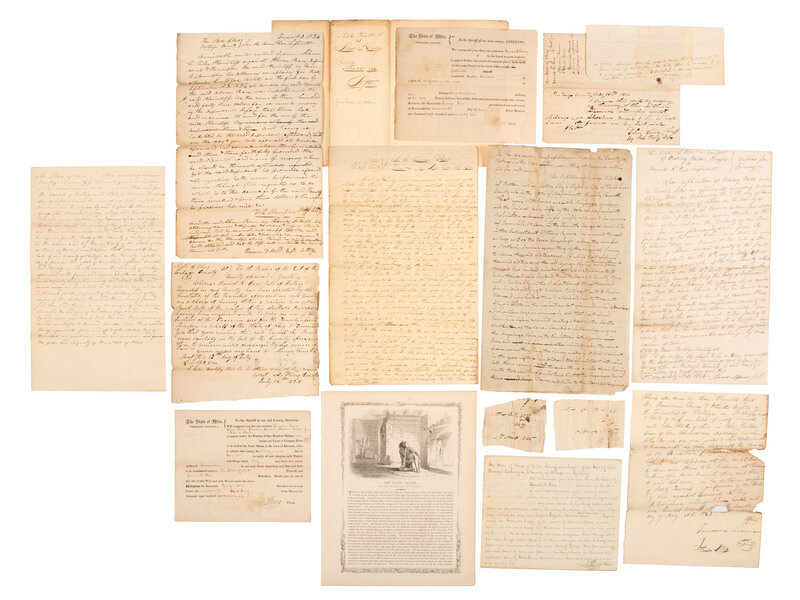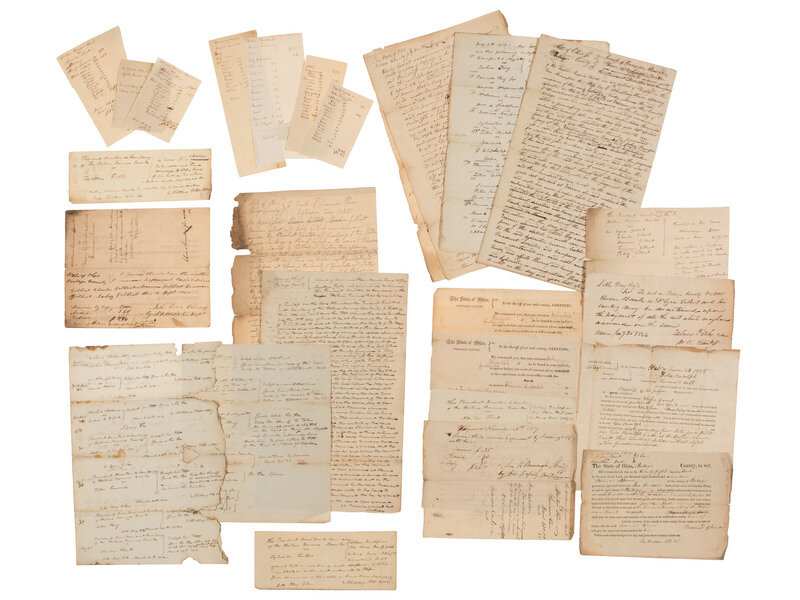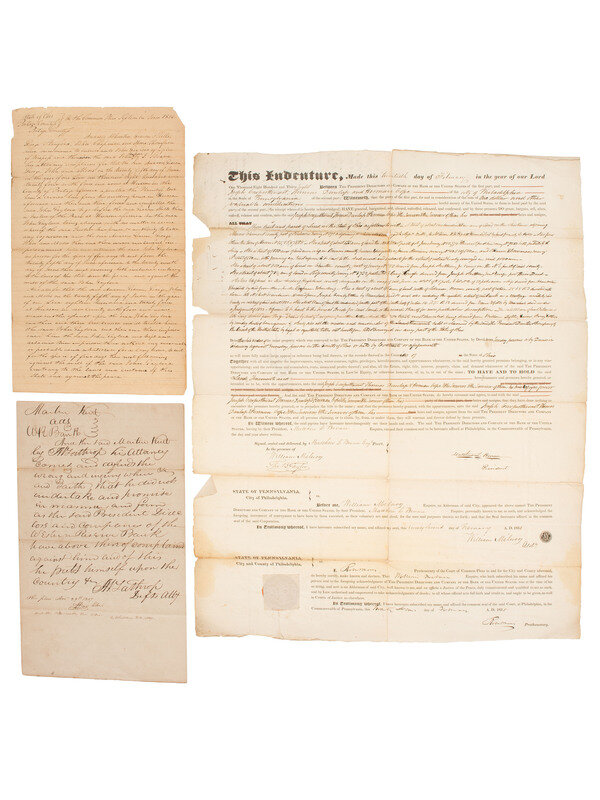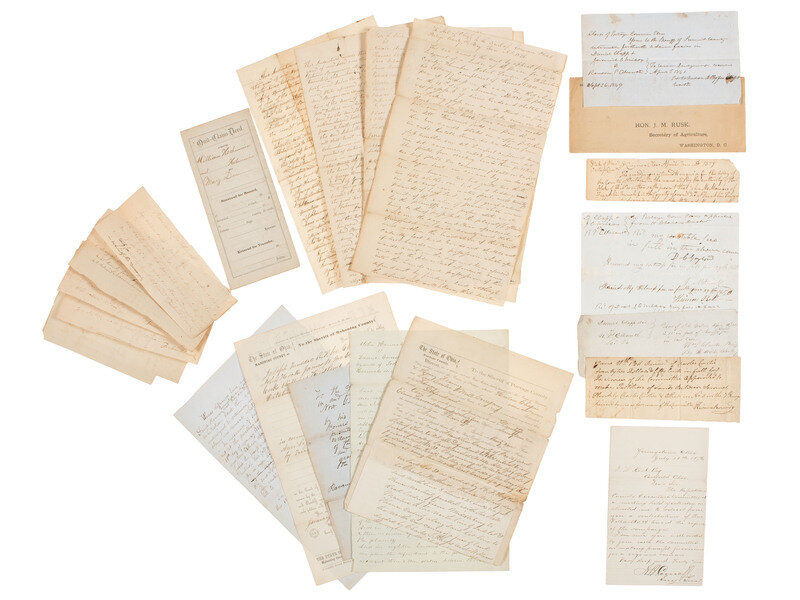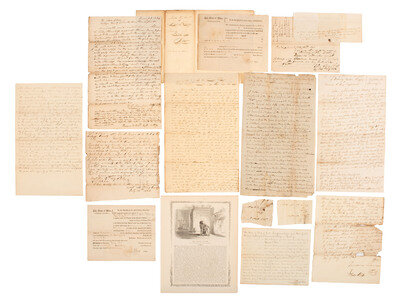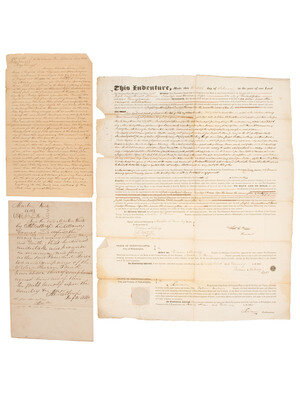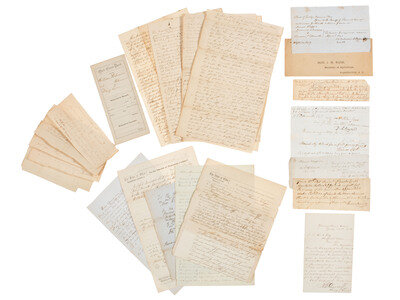Lot 585
[WESTERN EXPANSION]. Large group of documents related to early settlers of Ohio's Western Reserve (the Connecticut Western Reserve), ca 1806-1890.
Sale 2057 - American Historical Ephemera and Photography
Oct 25, 2024
10:00AM ET
Live / Cincinnati
Own a similar item?
Estimate
$1,000 -
1,500
Price Realized
$826
Sold prices are inclusive of Buyer’s Premium
Lot Description
[WESTERN EXPANSION]. Large group of documents related to early settlers of Ohio's Western Reserve (the Connecticut Western Reserve), ca 1806-1890.
86 documents related to the early history and settlement of the Ohio Western Reserve. Documents contain the signatures early settlers including businessmen, justices of the peace, attorneys, politicians, and militiamen. Sizes vary ranging from receipts of approx. 7 1/2 x 2 1/2 in. to larger legal documents of approx. 14 x 8 in. Various places. More than 60 documents dating from 1806-1850, with the remainder 1851-1890.
Highlights of the archive include: an 1810 legal petition filed by John Stark Edwards (1777-1813). Edwards was the son of Pierpont Edwards, who owned 1/20th of the Western reserve and was a co-founder of the Connecticut Land Company. John Edwards arrived in 1799 to the Western Reserve to take charge as sales agent of his father's lands. He was among the first lawyers in the territory and was the first man elected t the US Congress who resided on the Western Reserve, though he did not live to take his seat. -- An 1814 document signed by Oliver Snow (1775-1845) as Justice of the Peace. Snow and his wife Rosetta removed to the Western Reserve in 1805. They converted to the Church of Jesus Christ of Latter-day Saints after meeting the church's founder, Joseph Smith, in the early 1830s when he resided in nearby Hiram, Ohio. Oliver Snow's daughter Eliza would go on serve as a plural wife of both Joseph Smith and Brigham Young, and become one of the most celebrated Mormon women of the 19th-century. -- A group of 3 legal documents from 1826, with one signed by Van Rensselaer Humphrey (1800-1864) as a plaintiff's attorney. Humphrey defended Joseph Smith in the 1837 Kirkland, Ohio, trials, and was a cousin of abolitionist John Brown. --
Legal papers of Elisha Whittlesey (1783-1863), 26 documents related to the Western Reserve Bank, ca 1815-1820. Whittlesey served as Private Secretary to William Henry Harrison during the War of 1812, as an attorney for the Western Reserve Bank, and as a member of the US Congress. -- An 1812 summons signed by William Wetmore (1771-1827), founder of Cuyahoga Falls, commander of troops at Old Portage during the War of 1812. -- An indenture, 20 February 1838, between the Second Bank of the United States and several men who deeded properties in Ohio to the bank, presumably to extinguish debts owed. Indenture signed by bank president Matthew Bevan (1777-1849), Philadelphia businessman and politician William Milnor (1769-1848), lawyer and banker Thomas Dunlap (1793-1864), Thomas B. Taylor (1809-1852), Amos Terrell, David Crawford, David Banee, Gabriel Sellers, and A. Wright Reed. --A 10-document case file in the matter of Wells v Rex, including an 1826 document twice-signed by Major Miner Spicer (1776-1855) as Justice of the Peace. Spicer came on horseback to Ohio in 1810, was along with his family the first settlers of Portage Township, and was major of the militia in the War of 1812.
Additional papers related to James W. Lathrop, Jonathan Sloane, General Archibald Clark, Eben Newton, Reverend Adamson Bentley, Lucius Verus Bierce, Abner Pease, Bradford Kellogg, George Stidger, Calvin Austin, Darius Lyman, Elias Harmon, Colwell Porter, Frederick Daniels, Hiram Roundy, William Slater, Alvah Hand William M. Bear, David Wadsworth, Jeremiah Wadsworth, Alfred Wolcott, and more.
The Connecticut Western Reserve was a portion of land in northeastern Ohio claimed by the Colony of Connecticut and then the state of Connecticut. Encompassing 3.3 million acres and bounded on the north by Lake Erie, the 120-mile strip of land was sold by the state of Connecticut in 1795 to the Connecticut Land Company. In 1800, Connecticut surrendered all governing authority over the "Western Reserve" and shortly thereafter Arthur St. Clair, Governor of the Northwest Territory, designated the Western Reserve as Trumbull County. The last of the Connecticut Land Company's holdings were distributed in 1809, and soon the counties of Ashtabula, Cuyahoga, Erie, Huron, Geauga, Lake, Lorain, Medina, Portage (and portions of 5 others) would be carved out of the territory. Though relatively small and lesser-known than other territories, the Western Reserve region played an important part in the country's push westward. Early settlements included Cleveland (1796), Youngstown (1796), Warren (1798), and Ashtabula (1803). Described in 1859 by firebrand abolitionist John Brown as "the New England of the West," the Western Reserve region was home to the Underground Railroad and was staunchly anti-slavery. Later it would become a hub for railroad and steam transportation as well as the steel industry.
This lot is located in Cincinnati.
Condition Report
Contact Information
Auction Specialist
